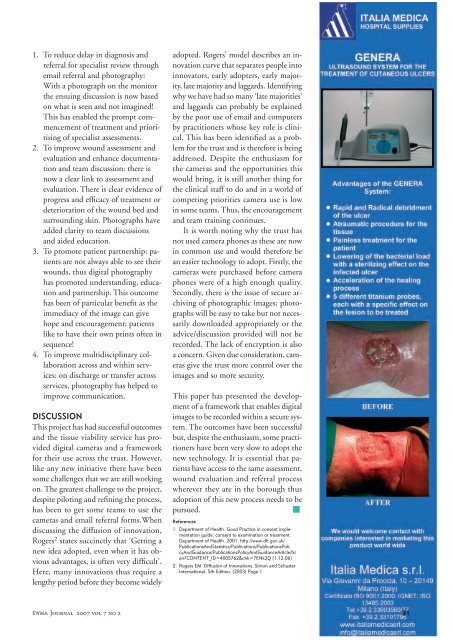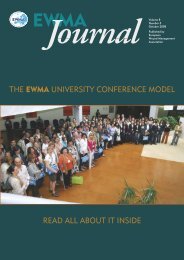You also want an ePaper? Increase the reach of your titles
YUMPU automatically turns print PDFs into web optimized ePapers that Google loves.
1. To reduce delay in diagnosis and<br />
referral for specialist review through<br />
email referral and photography:<br />
With a photograph on the monitor<br />
the ensuing discussion is now based<br />
on what is seen and not imagined!<br />
This has enabled the prompt commencement<br />
of treatment and prioritising<br />
of specialist assessments.<br />
2. To improve wound assessment and<br />
evaluation and enhance documentation<br />
and team discussion: there is<br />
now a clear link to assessment and<br />
evaluation. There is clear evidence of<br />
progress and efficacy of treatment or<br />
deterioration of the wound bed and<br />
surrounding skin. Photographs have<br />
added clarity to team discussions<br />
and aided education.<br />
3. To promote patient partnership: patients<br />
are not always able to see their<br />
wounds, thus digital photography<br />
has promoted understanding, education<br />
and partnership. This outcome<br />
has been of particular benefit as the<br />
immediacy of the image can give<br />
hope and encouragement; patients<br />
like to have their own prints often in<br />
sequence!<br />
4. To improve multidisciplinary collaboration<br />
across and within services:<br />
on discharge or transfer across<br />
services, photography has helped to<br />
improve communication.<br />
DISCUSSION<br />
This project has had successful outcomes<br />
and the tissue viability service has provided<br />
digital cameras and a framework<br />
for their use across the trust. However,<br />
like any new initiative there have been<br />
some challenges that we are still working<br />
on. The greatest challenge to the project,<br />
despite piloting and refining the process,<br />
has been to get some teams to use the<br />
cameras and email referral forms.When<br />
discussing the diffusion of innovation,<br />
Rogers 2 states succinctly that ‘Getting a<br />
new idea adopted, even when it has obvious<br />
advantages, is often very difficult’.<br />
Here, many innovations thus require a<br />
lengthy period before they become widely<br />
adopted. Rogers’ model describes an innovation<br />
curve that separates people into<br />
innovators, early adopters, early majority,<br />
late majority and laggards. Identifying<br />
why we have had so many ‘late majorities’<br />
and laggards can probably be explained<br />
by the poor use of email and computers<br />
by practitioners whose key role is clinical.<br />
This has been identified as a problem<br />
for the trust and is therefore is being<br />
addressed. Despite the enthusiasm for<br />
the cameras and the opportunities this<br />
would bring, it is still another thing for<br />
the clinical staff to do and in a world of<br />
competing priorities camera use is low<br />
in some teams. Thus, the encouragement<br />
and team training continues.<br />
It is worth noting why the trust has<br />
not used camera phones as these are now<br />
in common use and would therefore be<br />
an easier technology to adopt. Firstly, the<br />
cameras were purchased before camera<br />
phones were of a high enough quality.<br />
Secondly, there is the issue of secure archiving<br />
of photographic images; photographs<br />
will be easy to take but not necessarily<br />
downloaded appropriately or the<br />
advice/discussion provided will not be<br />
recorded. The lack of encryption is also<br />
a concern. Given due consideration, cameras<br />
give the trust more control over the<br />
images and so more security.<br />
This paper has presented the development<br />
of a framework that enables digital<br />
images to be recorded within a secure system.<br />
The outcomes have been successful<br />
but, despite the enthusiasm, some practitioners<br />
have been very slow to adopt the<br />
new technology. It is essential that patients<br />
have access to the same assessment,<br />
wound evaluation and referral process<br />
wherever they are in the borough thus<br />
adoption of this new process needs to be<br />
pursued. m<br />
References<br />
1. Department of Health. Good Practice in consent implementation<br />
guide: consent to examination or treatment.<br />
Department of Health. 2001. http://www.dh.gov.uk/<br />
PublicationsAndStatistics/Publications/PublicationsPolicyAndGuidance/PublicationsPolicyAndGuidanceArticle/fs/<br />
en?CONTENT_ID=4005762&chk=7ENk2Q (1.12.06)<br />
2. Rogers EM. Diffusion of Innovations. Simon and Schuster<br />
International. 5th Edition. (2003) Page 1<br />
<strong>EWMA</strong> Journal 2007 vol 7 no 2 1

















